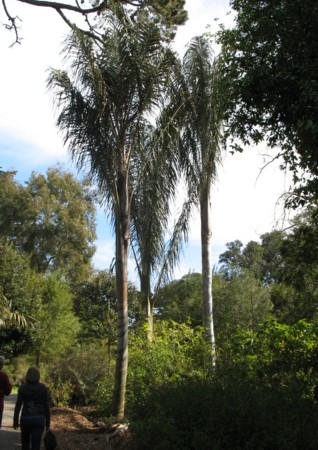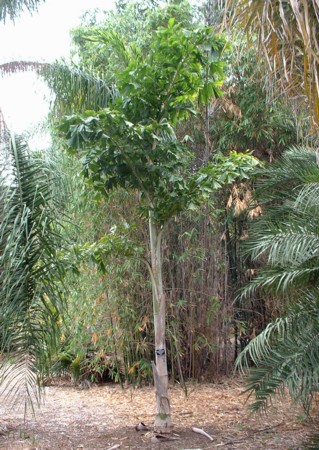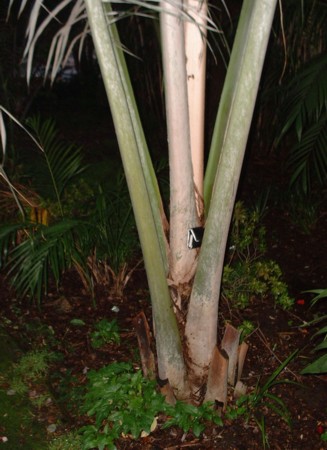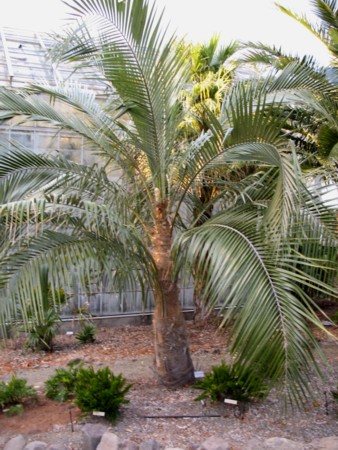Cold Hardy Highland Palms
This article first appeared in Hardy Palm International, Edition #51, August 2002. While many palm species popular in California are quickly catching on in the Pacific Northwest, one important group of potentially hardy palms remains largely forgotten. This group is the highland palms. A few are discussed in old books and articles, but they have been very slow to make their way into cultivation, and many remain shrouded in mystery. I would like to consider the geography and climate of their natural habitat, look at a few of the species that are starting to become better known, and examine their potential for cultivation in the Pacific Northwest. "Highland Palms" are a rather loosely defined group of palm species that inhabit high mountainous areas. They come exclusively from mountain ranges in the world's tropical or subtropical regions. Since these mountainous regions are significantly cooler than the steamy tropics, palms from here are best adapted to cool moist conditions. The species that grow closest to the equator, however, are not accustomed to seasonal change; requiring them to be somewhat adaptable to thrive in cultivation. Mountain ranges farther from the equator have more seasonal variation in rainfall and temperature, and are therefore more likely to contain species that will perform well in lowland temperate climates such as ours. In the Pacific Northwest they are likely to be best suited to cool coastal areas with less seasonal variation in temperature and cloud cover.
I will begin with the Himalayas, a subtropical mountain range containing the world's highest peaks. The climate in this region is characterized by a consistent seasonal pattern. Winters are typically cool and rather dry, but the weather turns extremely wet in late summer with the onset of the monsoon. Although this is the opposite of the Pacific Northwest's precipitation pattern, many plant species from this part of the world still adapt well here. The constant summer cloudiness in Southeast Asia and the Himalayas keeps the summer temperatures lower than one would expect for such a latitude, enabling many of these plants to tolerate our cool summers. One truly spectacular palm from the Himalayas is the cold-hardy Caryota (Fishtail Palm), recently introduced as C. 'Himalaya' by European palm experts Martin Gibbons and Tobias Spanner. It is actually a montane form of C. maxima. Some years ago it was introduced to cultivation under the name C. urens 'Mountain Form' to California. It is single-trunked, and, like other fishtails, it has beautiful, bipinnately compound leaves with sharply serrated edges. It grows in the Himalayan foothills near Darjeeling, India, to an elevation up to 8,000'; and it is also cultivated in Katmandu, Nepal. Gibbons estimates it will be hardy to about 19°F as a mature tree. However, this estimate might be slightly optimistic for all but the best provenances of this species - it will probably not be hardy enough to survive our Northwest Arctic blasts, but it would be a fun challenge to try with some protection in the most sheltered microclimates. Experience thus far has demonstrated that young plants are not very hardy at all, and may be killed by moderate frosts.
Although Caryota is a predominantly tropical genus, it is possible that more Caryota species with some hardiness may be found in Southeast Asia or the Himalayas in the future. C. basconensis and the Chinese C. ochalandra are somewhat frost tolerant, but probably not enough so to be worth attempting in our region. Anyone attempting to grow Caryota in the Pacific Northwest should wait until the palm reaches a fairly large size before putting it in the ground, and water and feed it heavily so that it will reach a large size quickly. Another promising palm recently discovered by Gibbons and Spanner in Bhutan and southern Tibet is Arenga micrantha. It is not huge, but very impressive, characteristically forming multiple trunks. It would probably be at least as hardy as Caryota sp. 'Mystery', and should certainly be a good bit hardier than A. engleri, which has been attempted by a few brave Northwest gardeners. Now we shall go to the Andes Mountains of South America, home to many fascinating genera of palms including Parajubaea and Ceroxylon. The climate there is one of perpetual coolness, and, in the north, and on the east side of the mountains, wetness. Most of the palms in this region are able to tolerate light frosts down to about 27°F, but some of the species that grow at extreme elevations, or south of the tropics towards Bolivia, are likely to be hardier. It will take quite a bit of adaptability on their part if they are to tolerate our Arctic blasts and seasonal variations in temperature and cloud cover. However, it seems certain that they will grow well in cool, wet weather - something we Northwesterners get more than our fair share of. Hot, dry weather is not to their liking, but I doubt this would be a problem in the Pacific Northwest with proper siting and watering.
Many Ceroxylon species grow near the equator, and are best adapted to perpetual coolness with no seasonal variation whatsoever. This will probably not be a palm for more extreme inland areas such as the Willamette Valley of Oregon. Some species also grow at lower elevations in warmer rainforests. The most southerly ranging species, and probably the best ones to try in our region, are C. parvifrons, C. vogelianum (syn. C. hexandrum) and C. parvum. These can be found growing above 9,000' in northern Bolivia. Of these, C. vogelianum has shown itself to be the most tolerant of some frost and difficult conditions for me. C. quindiense seems at least as hardy as C. parvifrons in my experience, and may also be worth trying. C. alpinum (syns. C. ferrugineum, C. andicola) is not as hardy as some literature suggests, and is actually one of the more heat-tolerant species, originating at a lower altitude. Until recently, most attempts to grow Ceroxylon in California were rather unsuccessful. However, some plants have flourished for a long time in the San Francisco area, and at the Huntington Botanic Gardens. Evidently they seem to have trouble withstanding the hot, dry summers in most of California; and overall they remain very rare. They are reported to develop dreadfully slowly from seed, typically remaining trunkless for 15 to 25 years - this is a palm to plant for your grandchildren! However, trunk development, when it finally begins, is very rapid, as much as 5' per year has been recorded in New Zealand.
Parajubaea species are also very beautiful palms, and has been described by some as reminiscent of the tropical looking coconut palm (Cocos nucifera). Fortunately for gardeners, although related to the slow-growing Jubaea chilensis (Chilean Wine Palm), they seem much faster-growing than both Jubaea and Ceroxylon. Repeated efforts to introduce Parajubaea cocoides to the San Francisco Bay Area from Quito, Ecuador, where it is common, have resulted in it being available from some nurseries, though scarce. This species comes from about 7,300 to 9,700' above sea level in Ecuador. A few Pacific Northwest gardeners have tried it, and found it hardy to about the mid-20s F as a young plant, though older specimens in California have recovered from temperatures as low as 16°F in 1990.
All Parajubaea species have a very vigorous, deep taproot system, and are probably not suited to long-term pot culture. If you are fortunate enough to obtain seeds, planting them in too shallow a pot is likely to stunt the growth of the plant. Like the other palms mentioned here, Parajubaea should be given careful winter protection for their first few years. They are likely to be more tolerant of our dryish summers than Ceroxylon. They may also hybridize with Jubaea in cultivation, which could make for some interesting future hardy palm possibilities. So, when will we see these palms towering over our gardens and cities? These palms are only now being trialled by pioneering palm growers and hobbyists, so no conclusive data will be available for many years. Some will not be fully hardy and will probably never be suited to widespread cultivation in the Pacific Northwest. The south coast of Oregon may give many highland species the protection from Arctic blasts they need for long-term survival. Others may find their microclimate of choice on islands in Puget Sound or the Strait of Georgia. If we're really lucky, a few may be completely hardy and adaptable throughout western Washington, Oregon and Southwest British Columbia. Some may fail completely. Perhaps one will someday replace Trachycarpus fortunei as our most popular hardy palm. In any case, the presence of these and other remarkable palms ensures many years of excitement ahead in the realm of cold-hardy palm cultivation. Future years promise the continuing discovery of "new" highland palm species, and continued introduction of species that have not been cultivated in our region before! |





